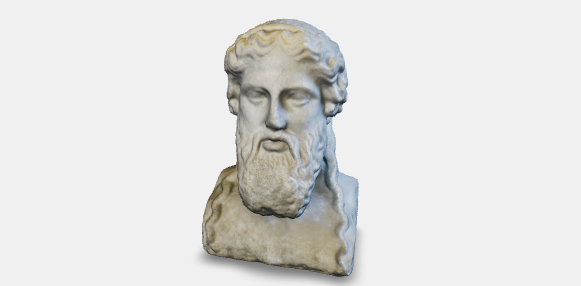Found in the waters of the port of Baia among the sunken remains of the imperial Palatium, this little herm show evident signs of exposition to the underwater environment, as shown by the numerous holes dug by lithodomes in the beard.
A Roman copy of a Greek original of the V century B.C. made in the famous workshop of copyists in Baiae. The head probably depicted Dionysus Lenaios (i.e. “of the wine-press”) from Agorakritos, a mighty god worshipped during the Lenaia, a series of festivals in Athens with wine pouring rituals and comical representations.
The artefact present signs of bioerosion like little circular holes (pitting) and sinuous grooves. The degradation phenomena are spread mostly on the front, especially on the beard, while in the back they are located in the lower area of the hair and on the shoulders.
The extension of the bio-deterioration covers approximately 80% of the surface. The pitting was attributed to endolithic sponges (Porifera of the family Clionaidae), while the grooves are caused by boring worms (Polychaetes of the family Spionidae). In some areas and under the beard in particular, numerous remains of the epilithic fouling organisms are still present.
The following image describes the degradation caused by boring sponges, showing the presence of tiny perforations on the surface and the erosion of the external layer of the marble, with a modest loss of sculptural plasticity. The colonisation of boring sponges is documented by SEM images that show visible bio-eroded cavities and pits.
The following image shows the degradation caused by boring worms, also visible to the naked eye and with well-defined sinuous grooves, generally U-shaped, superficial and sometimes deeply penetrating into the marble (see the diagram). Such a degradation is caused by the species Polydora ciliata and Dodecaceria concharum (see photo).


Davidde B., Ricci S., Poggi D., Bartolini M., 2010. Marine bioerosion of stone artefacts preserved in the Museo Archeologico dei Campi Flegrei in the Castle of Baia (Naples), Archaeologia Maritima Mediterranea; 7: 75-115.
Maniscalco, F. 1997, Ninfei ed edifici marittimi severiani del Palatium imperiale di Baia. Napoli: Massa Editore, p. 63.
Napoli, M. 1953 ‘Di una villa marittima di Baia’, Bollettino di Storia dell’Arte. Istituto Universitario di Magistero, Salerno, III(1), p. 95.
Zevi F. (cur.) 2009, Museo archeologico dei Campi Flegrei. Castello di Baia. Napoli: Electa Napoli, vol. 3, p. 133.
Ricci S., Sacco Perasso C., Antonelli, F., Davidde Petriaggi B., 2015. Marine Bivalves colonizing roman artefacts recovered in the Gulf of Pozzuoli and in the Blue Grotto in Capri (Naples, Italy): boring and nestling species. International Biodeterioration & Biodegradation (98) 89 – 100.
Ricci, S., Pietrini, A. M., Bartolini, M., Sacco Perasso, C., 2013. Role of the microboring marine organisms in the deterioration of archaeological submerged lapideous artifacts (Baia, Naples, Italy). International Biodeterioration & Biodegradation 82 (2013) 199-206.
Ricci S., Davidde B., Bartolini M., Priori G. F., 2009. Bioerosion of lapideous objects found in the underwater archaeological site of Baia (Naples). Archaeologia Maritima Mediterranea, 6: 167-188.



